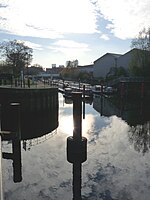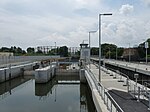Bow Back Rivers or Stratford Back Rivers is a complex of waterways between Bow and Stratford in east London, England, which connect the River Lea to the River Thames. Starting in the twelfth century, works were carried out to drain Stratford Marshes and several of the waterways were constructed to power watermills. Bow Creek provided the final outfall to the Thames, and the other channels were called Abbey Creek, Channelsea River, City Mill River, Prescott Channel, Pudding Mill River, Saint Thomas Creek, Three Mills Back River, Three Mills Wall River and Waterworks River.
The rivers have been subject to change over centuries, with Alfred the Great diverting the river in 896 to create a second channel, and Queen Matilda bridging both channels around 1110 by paying for the construction of Bow Bridge.
Because the river system was tidal as far as Hackney Wick, several of the mills were tide mills, including those at Abbey Mills and those at Three Mills, one of which survives. Construction of the New River in the seventeenth century to supply drinking water to London, with subsequent extraction by waterworks companies, led to a lowering of water levels, and the river was gradually canalised to maintain navigation. Significant changes occurred with the creation of the Lee Navigation in 1767, which resulted in the construction of the Hackney Cut and the Limehouse Cut, allowing barges to bypass most of the back rivers. A major reconstruction of the rivers took place in the 1930s, authorised by the River Lee (Flood Relief) Act, but by the 1960s, commercial usage of the waterways had largely ceased. Deteriorating infrastructure led to the rivers dwindling to little more than tidal creeks, and they were categorised in 1968 as having no economic or long-term future.
However, British Waterways decided that their full restoration was an important aim in 2002, and the construction of the main stadium for the 2012 Summer Olympics on an island formed by the rivers provided funding to construct a new lock and sluices which stabilised water levels throughout the Olympic site. It was hoped that significant amounts of materials for the construction of the Olympic facilities would be delivered by barge, but this did not happen. Improvements to the channels which form a central feature of the Olympic Park included the largest aquatic planting scheme ever carried out in Britain.











